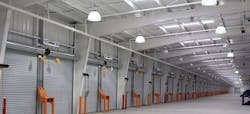Tapered columns can slim down costs
Metal building system builders have an option to use straight columns or tapered columns to hold up the structure. In many metal building applications, straight columns may have more steel than they need. A tapered column design can reduce the amount of steel used and reduce costs in several ways.
Metal building companies such as Star Buildings order flat plate steel in various widths and thicknesses. They cut shapes out of it to create a custom beam, typically made from three long plates: two wide flanges, with a perpendicular web separating them. The cross section looks like a capital I, the source of the term I-beam).
In a conventional I-beam, the web is a consistent depth and the flanges are parallel, that is, the two flanges are the same distance apart throughout the length of the beam. But if the web depth needed at the top of a column is different than the depth needed at the bottom, there’s no reason to make a conventional parallel beam.
The depth at the top is dictated by the roof rafter which the column is supporting. From an engineering standpoint, the rafter “knee” may need to be 60 inches deep. At the bottom of the column, the rotational force (moment) is zero, and may only need a depth of 12 inches to support the weight and resist horizontal shear.
In conventional construction, a contractor who buys a beam has no way to modify it. The structural steel of a metal building system is all custom made. The column can be easily tapered from 60 inches to 12 inches, if that’s what’s needed.
Tapering saves a lot of steel, which saves money on material cost. It also saves money in several other ways.
Less steel means less weight in shipping, which saves money. It also means less load that the foundation has to support, which saves money, especially in seismic zones, where weight also increases the seismic load.
It is possible to mix straight and tapered columns. The choice is typically dictated by the customer and by loads. Sometimes the design works better if the columns are straight, for example, if there are loads attached to the inside flange and you want a straight bracket, or if you’re putting in a crane. For a small building, the savings from tapering may be very small, too. In instances where the taper does not make enough difference to justify the cost of the set-up time in the fabricating shop, Star advises using straight columns. But in a large building, there can be great economy in tapering the shapes.

